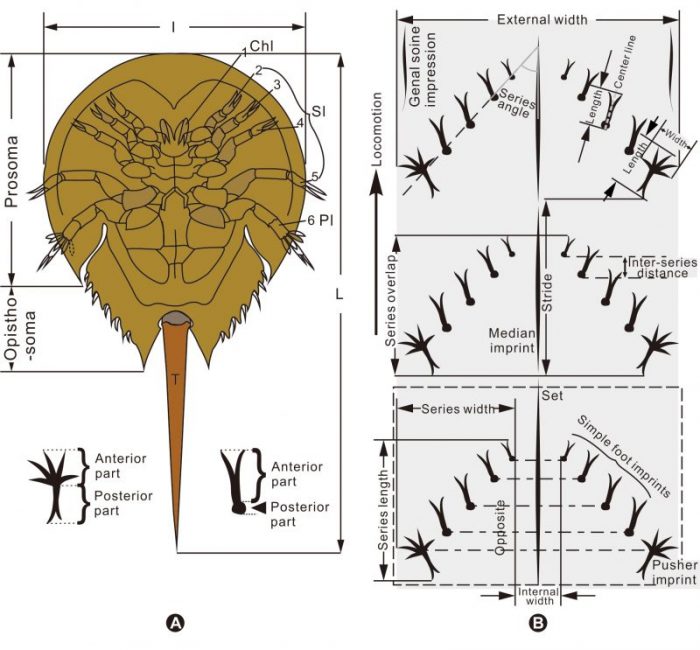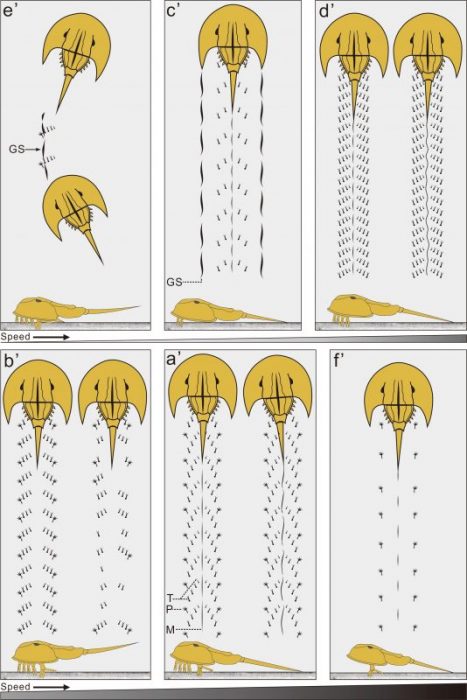
Horseshoe crabs, or limulids, are some of the strangest of shoreline creatures. There are only four species today, three of them living in shallow waters and mangroves around south Asia, and one, the Atlantic or North American horseshoe crab, living along the American Atlantic coast and the Gulf of Mexico.
Limulids have a hinged carapace, the larger portion in front and covering the head and body region, and a flap over the gills, finished by a long spike-like tail, or telson. They run about on five pairs of legs, which can also be used for swimming and for pushing food towards the mouth. They famously cluster on particular beaches on particular days for mass mating and spawning.
Limulids have a long history, and they do not appear to have changed much in terms of their body arrangement over the past 400 million years, and they are sometimes called “living fossils.” Fossils are common enough, but fossil trackways are very distinctive and can sometimes record their presence and activity in great detail. It is likely that their habit of mass mating and foraging for food along the shallow sea floor means their tracks can commonly be preserved.
In a new study (Shu et al. 2018), we were able to record horseshoe crab tracks from a succession of rocks that spanned the great Permian-Triassic (PT) mass extinction 252 million years ago. Limulids (of course) survived, but we had questions to ask about whether the devastating environmental changes associated with the mass extinction had in any way knocked them sideways.
The Permian-Triassic mass extinction was the most severe of all the mass extinctions, killing off more than 90% of species. It was driven by huge volcanic eruptions in Siberia that belched carbon dioxide, methane, and water vapor into the atmosphere. These collectively drove a shock global warming of 15 degrees, coupled with acid rain on land and ocean acidification. The acid rain stripped the land of plants and soils, which washed into the shallow seas and swamped filter-feeding life. The warming drove life from the tropics and stressed life elsewhere because it was coupled with a sharp drop in oxygen levels, especially in the oceans where the sea floors became anoxic.
Our study confirmed one thing: limulids are great survivors, plodding through these terrible catastrophes seemingly unfazed. But one thing did happen – they contracted in size, a common response to environmental stress among many marine animals, sometimes called the Lilliput effect.
Our study sections are in the Shanxi and Shaanxi provinces in north China, where a succession of terrestrial and marginal marine sediments span the PT boundary. Limulid trackways were recovered from all levels through the succession, and they can be recognized by their very characteristic patterns. They occur as arrow-shaped sets of five prints on each side – one formed by each of the ten feet, and those feet make definite branched little prints, sometimes with two toes, sometimes with three or four. Sometimes, their isolated little four-toed prints have been mistaken for out-of-place dinosaurs.

Fig. 1. A. Ventral view of a living limuloid animal (after Caster, 1938) and structures of simple foot imprints (T) and pusher imprints (P). 1. Chelicera (the first pair of appendages); 2, 3, 4, 5. The second to fifth pairs of appendages or the first to fourth pairs of walking legs; 6. The sixth pair of appendages or the fifth pair of walking legs or “pusher” legs. Chl., chelicera; Pl., pusher walking legs; Sl., simple walking legs; Gs, genal spine; I, width of prosoma; L, total length of limulid; T., telson.; B. Basic descriptive terminology and measuring proxies of limulid trackways. Credit: Wenchao Shu
In our work, we reviewed all limuloid tracks that had ever been reported from around the world. They are mostly assigned to the ichnogenus Kouphichnium, and we were able to rationalize the taxonomy to six species, which reflect different speeds of locomotion, from “wandering,” through “quick crawling,” to “jumping.”
The size changes went from track widths of around 6 cm in the Late Permian to a mere 2 cm in the earliest Triassic and bouncing back to 5 cm later in the Early Triassic. These track widths correspond to estimated horseshoe crab lengths of 13 cm, 4 cm, and 10 cm – all of them rather smaller than the largest horseshoe crabs today, where female Atlantic horseshoe crabs can be up top 48 cm (19 inches) long, and males 38 cm (15 inches) long.

Fig. 2. Sketch maps of the morphological-palaeoethological pattern showing the relationship between limuloid palaeoethology and trackways’ morphology. a’. quick crawling; b’. wandering in water near the bottom; c’. dragging clinging to the bottom; d’. half-crawling and half-walking near the bottom; e’. a sudden turn on the bottom when chasing or being chased; f’. jumping in water. Arrow indicates increasing speed of locomotion. Abbreviations: GS, genal spine impressions (GS); M, median impressions; P, pusher imprints; T, simple foot imprints. Sketches of A–J. All scale bars = 10 mm. Credit: Wenchao Shu
Uniformitarianism
For non-geologists, it might seem bizarre to be able to read such detail from ancient trackways, but the quality of preservation is superb, with the delicate tracks preserved as sharply as if they had been made yesterday. Because limulids have such delicate feet that make such predictable step patterns, paleontologists can work out the sequence of footfalls and even the speed of movement. In looking at a surface covered in such trails and tracks, we are literally looking at a snapshot of behavior preserved unchanged for millions of years.
Having living relatives that can be studied then gives the interpretations we can make on the ancient limulid trackways a great deal of validity because we estimate modes and speeds of locomotion by comparison with measurements made on the living relatives. This is the principle of uniformitarianism, as set down hundreds of years ago by the early founders of the subject, whereby geologists and paleontologists use their studies of modern processes and patterns to interpret what they see in the rock record.
So, when limulids became really tiny following the PT mass extinction, we know they were physically stressed. Oxygen levels were low, the ocean waters were acidified and heated, and food was short – horseshoe crabs maybe owe their long survival to their ability to reduce their food and oxygen demands by miniaturization until conditions improve and they can recover their size. A perfect survival strategy in tough times.
These findings are described in the article entitled Limuloid trackways from Permian-Triassic continental successions of North China, recently published in the journal Palaeogeography, Palaeoclimatology, Palaeoecology. This work was conducted by Wenchao Shu, Jinnan Tong, Daoliang Chu, Jianxin Yu, and Wenwei Guo from the China University of Geosciences, Li Tian from the China University of Geosciences and the University of Bristol, and Michael J. Benton from the University of Bristol.









